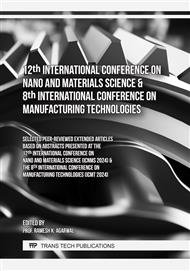[1]
Flower, D.J. and Sanjayan, J.G., 2007. Greenhouse gas emissions due to concrete manufacture. The International Journal of Life Cycle Assessment, 12, pp.282-288.
DOI: 10.1007/s11367-007-0327-3
Google Scholar
[2]
Cabeza, L.F., Barreneche, C., Miró, L., Morera, J.M., Bartolí, E. and Fernández, A.I., 2013. Low carbon and low embodied energy materials in buildings: A review. Renewable and Sustainable Energy Reviews, 23, pp.536-542.
DOI: 10.1016/j.rser.2013.03.017
Google Scholar
[3]
Živica, V., 2007. Effects of type and dosage of alkaline activator and temperature on the properties of alkali-activated slag mixtures. Construction and Building Materials, 21(7), pp.1463-1469.
DOI: 10.1016/j.conbuildmat.2006.07.002
Google Scholar
[4]
Fu-Sheng, W., Rui-Lian, S. and Ying-Jing, C., 2005. Study on modification of the high-strength slag cement material. Cement and concrete research, 35(7), pp.1344-1348.
DOI: 10.1016/j.cemconres.2004.10.017
Google Scholar
[5]
Abhilash, P., Sasidhar, C. and Ramana Reddy, I.V., 2017. Evaluation of Performance of Geopolymer Concrete in Acid Environment". International Research of Engineering and Technology (IJRET), 4(7).
Google Scholar
[6]
Rostami, M. and Behfarnia, K., 2017. The effect of silica fume on durability of alkali activated slag concrete. Construction and building materials, 134, pp.262-268.
DOI: 10.1016/j.conbuildmat.2016.12.072
Google Scholar
[7]
Wang, S.D., Scrivener, K.L. and Pratt, P.L., 1994. Factors affecting the strength of alkali-activated slag. Cement and concrete research, 24(6), pp.1033-1043.
DOI: 10.1016/0008-8846(94)90026-4
Google Scholar
[8]
Škvára, F., Šmilauer, V., Hlaváček, P.E.T.R., Kopecký, L.U.B.O.M.Í.R. and Cilova, Z., 2012. A weak alkali bond in (N, K)–A–S–H gels: evidence from leaching and modeling. Ceramics–Silikáty, 56(4), pp.374-382.
Google Scholar
[9]
Sun, K., Peng, X., Wang, S., Zeng, L., Ran, P. and Ji, G., 2020. Effect of nano-SiO2 on the efflorescence of an alkali-activated metakaolin mortar. Construction and Building Materials, 253, p.118952.
DOI: 10.1016/j.conbuildmat.2020.118952
Google Scholar
[10]
Wang, J., Zhou, T., Xu, D., Zhou, Z., Du, P., Xie, N., Cheng, X. and Liu, Y., 2018. Effect of nano-silica on the efflorescence of waste-based alkali-activated inorganic binder. Construction and Building Materials, 167,pp.381-390.
DOI: 10.1016/j.conbuildmat.2018.02.006
Google Scholar
[11]
Saludung, A., Azeyanagi, T., Ogawa, Y. and Kawai, K., 2021. Effect of silica fume on efflorescence formation and alkali leaching of alkali-activated slag. Journal of Cleaner Production, 315, p.128210.
DOI: 10.1016/j.jclepro.2021.128210
Google Scholar
[12]
Zhang, Z., Provis, J.L., Reid, A. and Wang, H., 2014. Fly ash-based geopolymers: The relationship between composition, pore structure and efflorescence. Cement and concrete
DOI: 10.1016/j.cemconres.2014.06.004
Google Scholar
[13]
Scherer, G.W., 2004. Stress from crystallization of salt. Cement and concrete research, 34(9), pp.1613-1624.
DOI: 10.1016/j.cemconres.2003.12.034
Google Scholar
[14]
Ye, H. and Radlińska, A., 2016. Shrinkage mechanisms of alkali-activated slag. Cement and Concrete Research, 88, pp.126-135.
DOI: 10.1016/j.cemconres.2016.07.001
Google Scholar
[15]
Prud'homme, E., Michaud, P., Joussein, E., Peyratout, C., Smith, A., Arrii-Clacens, S., Clacens, J.M. and Rossignol, S., 2010. Silica fume as porogent agent in geo-materials at low temperature. Journal of the European Ceramic Society, 30(7), pp.1641-16
DOI: 10.1016/j.jeurceramsoc.2010.01.014
Google Scholar



